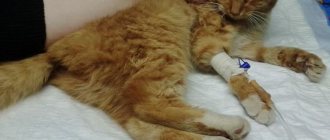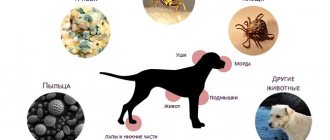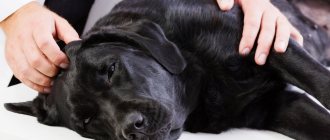Relaxing and therapeutic massage treatments are recommended not only for people, but also for pets. With their help, you can relieve muscle pain and even improve the functioning of the gastrointestinal tract. If you don’t know how to massage dogs, then you don’t have to constantly go to a veterinary clinic for this service. With enough practice, you can master the technique yourself.
When is massage indicated for a dog?
The procedure is carried out for therapeutic and preventive purposes. In the first case, it is prescribed in the presence of the following pathologies:
- Nervous disorders
. Massage actions relax the body, calming the nervous system. This helps to cope with stress and exciting events.
- Various pain syndromes
. Thanks to the stimulating effect, histamine production in the subcutaneous tissue improves. All spasmodic vessels dilate, so existing pain subsides or disappears completely.
- Injuries
. Stimulation of blood circulation improves metabolism, accelerating the regeneration of damaged tissues.
- Constipation
. The technique used improves intestinal motility, facilitating bowel movements.
- Diseases of the musculoskeletal system
(joint degeneration, paralysis). Stimulation of motor nerves and strengthening of muscle tissue make it easier for a sick animal to move, helping to restore lost function.
If the dog is completely healthy, then it is recommended to massage it for preventive purposes. Regular sessions will help maintain healthy bones and muscles until old age, as well as relieve fatigue accumulated during the day.
Characteristics of the disease
Intervertebral discs consist of a fibrous membrane and a nucleus pulposus. Thanks to them, the hard vertebrae do not touch each other and are not deformed by friction.
When the disease occurs, the soft contents harden. It becomes overgrown with fibrous tissue, and its gelatinous consistency changes to cheesy. The outer shell becomes porous and brittle. Under pressure from the vertebrae, it flattens and collapses.
Due to the displacement of the natural “shock-absorbing cushion”, the nerve roots of the spinal cord are under increasing pressure. If pinched for too long, motor function is lost forever, so it is very important not to self-medicate and seek help at the first sign of discomfort.
We recommend reading: Cat Vomits Foam Doesn’t Eat
Types of massage
Depending on the goal being pursued, several techniques are distinguished. They can be divided into 3 large groups:
- Relaxing
. Suitable for relieving nervous tension and deep relaxation. All actions performed are focused on the spine area.
- Preventive
(wellness). Aimed at improving muscle tone and increasing the elasticity of joints and ligaments. This type is suitable for preventing chronic diseases and maintaining overall health.
- Medicinal
(rehabilitation). This group includes all varieties recommended for recovery after operations, injuries and diseases of the musculoskeletal system. With their help, the animal returns to its normal life.
Separately, it is worth highlighting the cosmetic appearance offered in grooming salons. It is a combination of a complex of care procedures and relaxing massage movements.
All of the above techniques can be performed at home. The only difficulty may arise with hydromassage, a type of medical procedure. It is carried out only in a limited number of veterinary clinics equipped with a special bath for ozone therapy.
Are there any contraindications?
Like any medical procedure, massage for dogs has a number of contraindications. These include the following conditions:
- any skin lesions (neoplasms, open wounds, inflammation, ulcers, eczema);
- fresh fractures with severe pain;
- acute or advanced kidney and liver diseases;
- heat;
- bleeding;
- epilepsy or shock.
Please note that even in the absence of the listed contraindications, you should consult a veterinarian before starting home sessions. He will not only select a more effective technique, but also explain its main nuances.
Exercises to develop and strengthen a dog’s hind legs
Exercises on the limbs can be performed with or without additional equipment (platforms, fitball, weights).
Examples of classes without special equipment:
- Stand on hind legs
. Executed by the “serve” command. In order for the dog to rise on its hind legs, you can lure it with a piece of treat (for example, a dog food pellet). The number of repetitions and duration of standing must be increased gradually. For the first time, time how many seconds the dog stands, then each time add a second for repetition. You can start with three executions of the “serve” command. - Jumping up
can be done by tossing a dog object or luring it with a treat. The dog needs to swim so many times until he gets tired. - Swimming
. If you have access to ponds in the summer or to a pool year-round, exercise in the water will perfectly help strengthen the muscles of the limbs. The activity should be in a playful way. You can throw a stick or ball into the water and command them to bring it back. You don’t need to throw it far right away until you are 100% sure that the dog can swim to the shore on its own. With each workout, gradually increase the distance for swimming and the number of times. - Running uphill
. It is carried out in the same way as swimming in a playful way, by throwing the dog’s favorite object up the mountain. The dog must bring it every time. Repeat as many times as possible until the dog gets tired. - Climbing stairs
. You can walk with your dog together in a multi-story building. But the best option would be a long city staircase, for example in a park. The exercise is carried out in the same way as running uphill. The owner throws a dog toy up the stairs, the dog runs after it and then returns it to the owner. Then the item is thrown again.
You can play until the dog gets tired.
Techniques for different types of massage
The massage movements used for four-legged pets are softer. Excessive force can cause harm, so it is important not only to time your efforts, but also to understand the peculiarities of canine physiology and anatomy.
Despite some differences, all available types involve the following hand movements:
- strokes that relax the body;
- fingertip tapping to help warm up the body at the very beginning;
- twisting, kneading tissue under the skin;
- rubbing, increasing blood flow and eliminating adhesions;
- compression (shaking) to relieve muscle spasms.
To obtain the desired results, you must devote at least 10 minutes to the procedure every day. At first, you should choose the minimum time to allow the animal to get used to unusual actions. If dissatisfaction appears (trembling, growling), it is recommended to stop the session.
Relaxing
First, prepare a flat surface by covering a table or regular floor with a soft cloth. You can put a muzzle on an aggressive pet, but you still shouldn’t abuse this accessory for a long time. Your pet should enjoy the session, so do not force him against his will.
After preparing a comfortable place, use the step-by-step algorithm that explains how to massage dogs:
- Start with light strokes. Use your fingertips and the inside of your palm to move around your entire body. Scratch the scruff of the neck and be sure to praise your pet so that he feels safe and as relaxed as possible.
- Massage your neck in a circular motion, moving from top to bottom. Perform all movements smoothly so as not to damage the vertebrae.
- Knead your ears and surrounding area. Be careful. The area between the ears is especially sensitive, as there are many nerve endings there.
- Using similar circular movements, stretch your shoulders and rotate the ponytail around its axis three times in different directions.
- Complete the procedure by stroking, moving from the back of the head to the tail.
Despite interaction with a rather limited number of areas (ears, withers, back, tail), relaxation occurs throughout the body. This occurs thanks to the neurons of the spinal column, which transmit signals even to the most distant areas.
Anesthetic
The technique for performing this type is similar to a relaxing massage for dogs, focusing on the back. The only difference is that the working area will depend on the location of the source of pain.
Use stroking, rubbing and light twisting, but do not directly affect the source of pain. You should also avoid contact with existing tumors. Stimulating blood circulation can affect their growth.
If your pet's paws hurt, use the tips recommended for paralysis. In other cases, you can adhere to the relaxation technique algorithm.
Medicinal
The technique for performing this type depends on the problem at hand. It is prescribed for constipation, paralysis, recent stroke, mastitis, dysplasia, arthritis and other pathologies.
If your pet has been diagnosed with a disease that requires a course of massage sessions, discuss this issue with your veterinarian. He will explain which area should be given the most attention and with what force it is permissible to massage problem areas.
For good peristalsis
Immediately after birth, the mother monitors peristalsis, regularly kneading the babies’ tummies with her paws and tongue. But intestinal problems bother dogs even at an older age. At this point, taking care of their health falls entirely on the owner.
To prevent constipation, you need to regularly massage your sides and stomach, moving clockwise. Start the procedure with light circular strokes at the chest and smoothly move towards the tail, gradually increasing the diameter of the working area and the intensity of palpation. The appearance of gurgling sounds during the procedure is a normal reaction, confirming the effectiveness of the therapy used.
Avoid putting too much pressure on the abdominal wall. It can damage internal organs. It is also recommended not to touch the groin area. Such touches cause a negative reaction in most animals.
For paralysis
For problems with the musculoskeletal system, it is recommended to focus on twisting and shaking. With their help, you can restore damaged muscles and nerves.
During the session, do the following:
- Calm your pet with light stroking of the entire body. Move to the paws as soon as he relaxes.
- Stroke one of the sore limbs, moving from its base straight to the heels. Gently bend it at the elbow or knee. Return the paw to its original position and repeat the previous action 4 more times.
- Massage the limb in a circular motion, moving from the inner surface to the outer. Having reached your heels, repeat the above steps 3 more times.
- Rub your hand or foot vigorously, not forgetting the space between your toes. Control the force used so as not to harm the animal.
After massaging one of your dog's paws, immediately move on to the other. Please note that it is necessary to act not only on the sore limb, but on everything at once.
Causes of hind leg paralysis
Many factors have been identified that lead to the development of paralysis of a pet's hind legs. Among them are:
- traumatic injuries . Any fractures, sprains and tendon ruptures can not only significantly limit the dog’s motor activity, but also damage peripheral nerve fibers. As a result, innervation is disrupted and paralysis develops;
- neoplasms . Malignant and benign tumors affect the nervous system in 4% of cases. Any localization of the proliferative process (in the brain and spinal cord, not in the periphery) can disrupt the functions of the nerve trunks. Also, impulse conduction can be changed when nerve tissue is compressed by nearby pathological foci;
- joint diseases – arthritis, arthrosis;
Arthritis and arthrosis
- spinal pathologies . Herniated intervertebral discs, discopathy, and scoliosis disrupt the normal anatomy of the spinal canal, during which the spinal cord can be compressed in any area and the innervation ceases. The higher the localization of the lesion, the more organs lose their function. For example, damage to the thoracic or lumbar spinal cord leads to denervation of the pelvic organs;
- degenerative bone diseases. Spondylosis (spike-like growth of vertebral tissue towards the spinal cord), spondyloarthrosis (protrusion of the annulus pulposus of the spinal disc), discopathy (penetration of disc components into the brain canal) provoke compression of nerve cells. Against the background of long-term adverse effects, adequate oxygen supply is disrupted and nerve tissues die;
Spondyloarthrosis on x-ray
- unsuccessful movements . Prolapse of spinal discs, dislocations and fractures of various parts of the axial bone formation can occur with excessively active movements and unsuccessful turns;
- allergic polyneuropathy . Allergopathology can affect any organs, including the nervous system. Deviations occur when exposed to any allergens: household, medicinal, food, etc.;
- viral and bacterial infections affecting the spinal cord or brain (myelitis, meningitis, encephalitis, etc.). Not only damage to nerve fibers with the development of edema and destruction in them is dangerous, but also the action of poisons and toxins of pathogens;
- ischemic and hemorrhagic strokes . Pathology can occur due to various reasons: atherosclerotic damage to the vessels of the central nervous system, stress in the dog, increased blood pressure, massive injuries. As a result, a specific part of the nervous system is shut down.
Compression of the contents of the spinal canal









